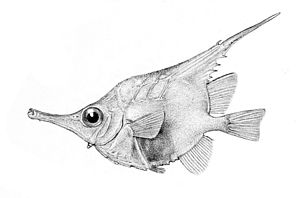Orange bellows fish
| Orange bellows fish | ||||||||||||
|---|---|---|---|---|---|---|---|---|---|---|---|---|

Orange bellowfish ( Notopogon xenosoma ) |
||||||||||||
| Systematics | ||||||||||||
|
||||||||||||
| Scientific name | ||||||||||||
| Notopogon xenosoma | ||||||||||||
| Regan , 1914 |
The Orange bellows fish ( Notopogon xenosoma ) is a small sea fish from the group of Seenadel-like . It occurs in tropical and subtropical seas in the southern hemisphere. Fish of this species have so far been detected in Madagascar , from the South African Algoa Bay near New Zealand and New Caledonia in the southern Atlantic near Tristan da Cunha and Gough Island .
features
The orange bellows fish can reach a maximum length of 17 centimeters. Its body is high back and almost round. Together with the head, which ends in a long, tubular mouth, the result is a shape that is reminiscent of a bellows . The first dorsal fin is supported by seven fin spines, of which the first is very much elongated in adult fish, and in contrast to that of the European bellows fish ( Notopogon lilliei ) is at least as long as the length of the tubular mouth. The second dorsal fin and the anal fin are approximately symmetrically opposite each other above and below the tail fin stalk. The second dorsal fin is supported by 15 to 16, the anal fin by 17 to 18 soft rays. The orange bellows fish is solid orange or brownish-red in color.
Way of life
Orange bellows fish live close to the ground above the shelf of continents and islands at depths of 255 to 610 meters. They likely feed on small, plankton crustaceans . Their way of life is largely unknown.
footnote
- ↑ (gr.) Notos "back", pōgōn "beard" (also in the sense of "train"), xenos "strange", sōma "body"
literature
- Rudie H. Kuiter : Seahorses, pipefish, shredded fish and their relatives , 2001, Verlag Eugen Ulmer, Stuttgart, ISBN 3-8001-3244-3
Web links
- Orange bellows fish on Fishbase.org (English)